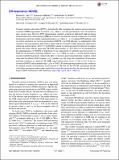| dc.contributor.author | Jain, Sheetal Kumar | |
| dc.contributor.author | Mathies, Guinevere | |
| dc.contributor.author | Griffin, Robert Guy | |
| dc.date.accessioned | 2020-06-23T17:57:45Z | |
| dc.date.available | 2020-06-23T17:57:45Z | |
| dc.date.issued | 2017-10 | |
| dc.date.submitted | 2017-08 | |
| dc.identifier.issn | 0021-9606 | |
| dc.identifier.uri | https://hdl.handle.net/1721.1/125934 | |
| dc.description.abstract | Dynamic nuclear polarization (DNP) is theoretically able to enhance the signal in nuclear magnetic resonance (NMR) experiments by a factor γ[subscript e]/γ[subscript n], where γ's are the gyromagnetic ratios of an electron and a nuclear spin. However, DNP enhancements currently achieved in high-field, high-resolution biomolecular magic-angle spinning NMR are well below this limit because the continuous-wave DNP mechanisms employed in these experiments scale as ω[superscript -n over subscript 0] where n ∼ 1-2. In pulsed DNP methods, such as nuclear orientation via electron spin-locking (NOVEL), the DNP efficiency is independent of the strength of the main magnetic field. Hence, these methods represent a viable alternative approach for enhancing nuclear signals. At 0.35 T, the NOVEL scheme was demonstrated to be efficient in samples doped with stable radicals, generating [superscript 1]H NMR enhancements of ∼430. However, an impediment in the implementation of NOVEL at high fields is the requirement of sufficient microwave power to fulfill the on-resonance matching condition, ω0I = ω1S, where ω[subscript 0I] and ω[subscript 1S] are the nuclear Larmor and electron Rabi frequencies, respectively. Here, we exploit a generalized matching condition, which states that the effective Rabi frequency, ω[superscript eff over subscript 1S], matches ω[subscript 0I]. By using this generalized off-resonance matching condition, we generate [superscript 1]H NMR signal enhancement factors of 266 (∼70% of the on-resonance NOVEL enhancement) with ω[subscript 1S]/2π = 5 MHz. We investigate experimentally the conditions for optimal transfer of polarization from electrons to [superscript 1]H both for the NOVEL mechanism and the solid-effect mechanism and provide a unified theoretical description for these two historically distinct forms of DNP. | en_US |
| dc.description.sponsorship | National Institutes of Biomedical Imaging and Bioengineering (grant nos. EB-002804 and EB-002026) | en_US |
| dc.language.iso | en | |
| dc.publisher | AIP Publishing | en_US |
| dc.relation.isversionof | 10.1063/1.5000528 | en_US |
| dc.rights | Article is made available in accordance with the publisher's policy and may be subject to US copyright law. Please refer to the publisher's site for terms of use. | en_US |
| dc.source | PMC | en_US |
| dc.title | Off-resonance NOVEL | en_US |
| dc.type | Article | en_US |
| dc.identifier.citation | Jain, Sheetal K., Guinevere Mathies, and Robert G. Griffin, "Off-resonance NOVEL." Journal of Chemical Physics 147, 16 (Oct. 2017): no. 164201 doi 10.1063/1.5000528 ©2017 Author(s) | en_US |
| dc.contributor.department | Massachusetts Institute of Technology. Department of Chemistry | en_US |
| dc.contributor.department | Francis Bitter Magnet Laboratory (Massachusetts Institute of Technology) | en_US |
| dc.relation.journal | Journal of Chemical Physics | en_US |
| dc.eprint.version | Final published version | en_US |
| dc.type.uri | http://purl.org/eprint/type/JournalArticle | en_US |
| eprint.status | http://purl.org/eprint/status/PeerReviewed | en_US |
| dc.date.updated | 2019-12-18T13:19:31Z | |
| dspace.date.submission | 2019-12-18T13:19:33Z | |
| mit.journal.volume | 147 | en_US |
| mit.journal.issue | 16 | en_US |
| mit.metadata.status | Complete | |
